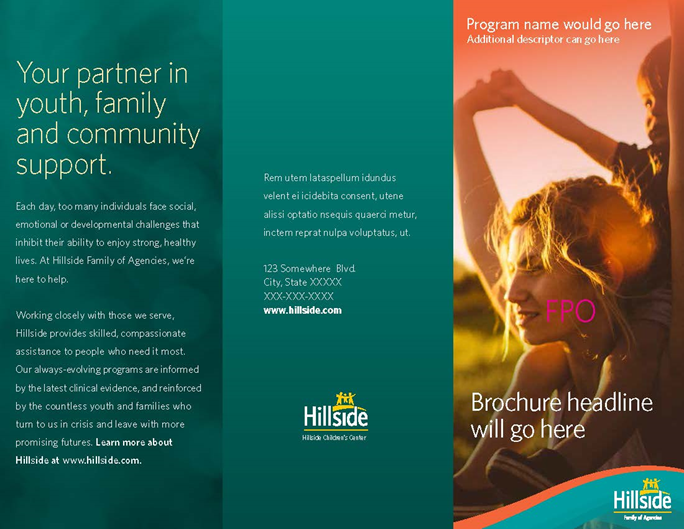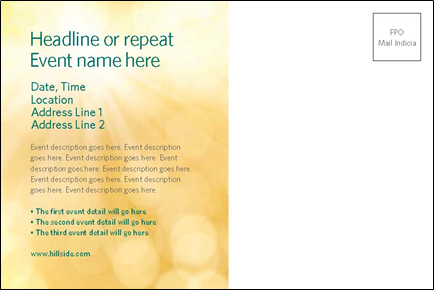There can be many obstacles when promoting your organization’s services and overall mission. Many organizations find their efforts stalled by either limited resources or challenges around brand messaging. This often leads to an absence of universal buy-in, which is crucial. Hillside Family of Agencies, COA accredited since 2006, successfully navigated these common stumbling blocks by launching an organization-wide, ready-to-use, user-friendly collateral ordering system called the Turnkey Marketing Toolkit.
Hillside Family of Agencies (Hillside) is one of the oldest and largest human service organizations in the U.S., offering child welfare, developmental disabilities, education, juvenile justice and mental health services across central and western New York; Washington, DC; and Prince George’s County, MD. Through the five agencies – Hillside Children’s Center, Hillside Children’s Foundation, Hillside Work-Scholarship Connection, Snell Farm Children’s Center and Stillwater Children’s Center – that comprise Hillside, it serves 13,000 youth and adults annually. Its structure as a family of agencies allows specialization as well as a systematic approach to support children, youth and families aimed at breaking the damaging cycles of poverty, trauma and neglect.
So, how does a multi-state organization that serves a diverse group of clients create marketing materials with consistent branding for 100+programs hosting 100+events per year? We interviewed Brandie Cain, Senior Communications Associate from Hillside to learn more about the evolution of the Turnkey Marketing Toolkit to better understand the struggles and successes.
The beginning/the motivation
The project started when Hillside invested resources in a marketing team, a new endeavor for the agency. Before the arrival of the marketing team, each program was responsible for developing outreach materials for families, funders, partners and other stakeholders about their work. This created a duplication of design efforts and put their marketing pieces at risk for typos, inconsistencies in strategic messaging, design quality, branding, style and printing quality. For example, some programs used professional design tools like Adobe, some used Microsoft Word. Some printed items in-house and some used professional printers.
Once the team was in place, they were set to take on the challenge of refining Hillside’s mission and honing in on its impact while considering the diverse skills, identities and clients across the family of agencies. And the hurdles didn’t end there. Although centralizing a marketing team for support and quality control was a crucial foundation step, the team didn’t have the capacity to meet the oversight demand. The quantity of time-sensitive marketing materials requiring approval was too many for staff to manage and unscalable. The team saw an opportunity to innovate and got to work on a better process.
Understanding the work
As a first step, the marketing team engaged with the programs by attending staff meetings to review the content created by programs and better understand their marketing needs. They approached program staff with the perspective of being a support, not an enforcer, which helped build a foundation of trust.
Through this outreach effort, the marketing team found similarities across programs and carefully planned what collateral was needed, finding a balance between customization for each program and consistency needed for organization-wide branding and messaging. This balance was essential to gain buy-in from program staff who were accustomed to creating materials to meet their needs and transition them to shared pieces that could serve many programs.
Determining types of collateral to produce
After this assessment/evaluation was conducted, all of the marketing pieces that were being created by programs fell into one of two categories:
- Event-based – fundraisers, trainings, outreach events, etc.
- Informational – overview pieces about a program’s work, information about becoming a foster parent
With this categorization, the marketing team was able to narrow down the types of collateral to brochures, posters and postcards. The team created slight variations for each and templates with organizational colors, branding and messaging. Additionally, the templates contained designated areas and prompts for important event and program information.
Centralizing design
By creating these templates, the marketing team saved countless hours of work by eliminating the need for program staff spend time making design choices – things like font hierarchy (styles for titles, headers, sub-headers and paragraph text), where text should be placed (on or next to photos) and text alignment.
The templates allowed these design choices to be made by the experts in design – the marketing team! As much as we wish to believe that there’s a budding graphic designer within all of us, we’ve also all experienced a formatting task that took twice as long as expected and produced a less than desired result. It’s been said before and it is true – good design takes a lot of work.
Lastly, one of the greatest benefits of the centralized templates is the marketing team can now easily roll out new colors, logos, and messaging without worrying about old versions being used.
Creating customization
The marketing team knew that programs still needed the ability to customize content to reflect the services provided by each program and convey event specific information. Therefore, they crafted the brochure template language in a way that wove together organization-wide and program-specific messaging. The templates provide paragraph length guidance and bullet list prompts to help programs frame their work in concise messages.
More importantly, programs are able to change the photos in the templates to select images that will resonate with its stakeholders. In consultation with the programs, the marketing team curated and now maintains a high quality image library. The marketing team ensures that all of the photos are available for use and credited appropriately, thus eliminating the risk of copyright infringement or use of photos taken of clients or stakeholders without permission. The photos are pre-formatted to fit the templates and program staff can easily drag and drop which photos they would like to use in each piece.
Operationalizing
Next, the marketing team worked to set up an infrastructure and made sure it addressed anticipated pain points. They knew in order for people to use the new Turnkey Marketing Toolkit, it needed to be fast in turn-around time (72-hour target), easy to use, save order history, offer simple re-ordering, and produce high quality pieces.
They worked with a printing vendor to create an online system with the ability to create user login accounts with order history and an approval hierarchy that allows the marketing team to approve content (quality control) and program supervisors approve large orders (expense control). A link to the portal was shared internally with leadership and program staff and then placed on Hillside’s website for all to access.
Launching the Turnkey Marketing Toolkit
Building on the relationships created during the assessment and building phases, the team rolled out the Turnkey Marketing Toolkit during all-staff meetings hosted by programs. They shared how the new centralized tool facilitates collaboration of internal experts without duplication of efforts. The marketing staff contribute the branding and design and program staff contribute their knowledge of the appropriate imagery and audience-specific messaging.
Gauging success
The Turnkey Marketing Toolkit was well received and program staff quickly adopted the system for ordering materials. Now almost 3 years since its launch, they have experienced the benefits of consistency in the look and feel of collateral across programs, the reduction of marketing staff’s time reviewing and approving different designs, and access to organization-wide data on how many pieces exist and are printed annually. There also have been some unexpected benefits. For example, the marketing team is now aware of when events are taking place and can schedule a person to attend to take photos and gather stories to raise awareness about how programs are impact their community and persons served. In addition, the ease of use and quick turnaround time has fostered a positive collaboration and trust between marketing and program staff. That’s not to say it was flawless from the start. The system has had some trial and error/has room for improvement. The marketing team have made some tweaks to the system along the way, such as adding designated quantities for orders (50, 75, 100, 200, 500 max), adding watermarks to proofs to deter self-printing, and adding a cost allocation element so that each program is responsible for the costs of its order.
Shareable lessons
Hillside’s ability to innovate when presented with the opportunity is inspiring. They designed a solution that retained the programs’ ability to customize their content while relieving them of the heavy lift of the design work. The organization gained a birdseye view of the frequency of use and purpose of all collateral, quality control of text and design and maximized resources by centralizing design time, photography acquisition and printing costs.
If you find yourself with many mini-design and printing departments within your agency, setting up a structure similar to Hillside’s centralized Turnkey Marketing Toolkit could be a solution for your organization. Don’t have a Marketing Department? Crowdsource your templates through a staff competition and/or find a staff person with design skills and interest. Use online tools like Canva or Moo for free templates and on-demand printing. Create your own curated photo library with free photos from Unsplash, rawpixel, and pixabay. Have other great tools? Share them in the comments!



